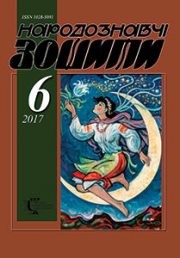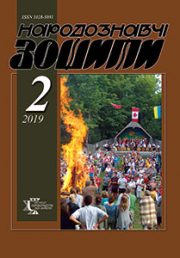The Ethnology Notebooks. 2020. № 1 (151), 229—232
UDK745.51:008(477.83/.86)”18/19″
DOI https://doi.org/10.15407/nz2020.01.229
ODREKHIVSKYI Roman
ORCID ID: https://orcid.org/0000-0003-3581-4103
Doctor in Art Studies, Associated Professor
Professor of the Department of Design,
Ukrainian National Forestry University,
Str. of General of Chuprynka, 103, Lviv, Lviv area, 79057
Contacts: e-mail: odre2010@ukr.net
Abstract. Introduction. During the rise of the national development of the state and society development the environmental design of the religious structures of the entire Ukraine and regions in particular becomes an important and actual issue. This is the reason why the theme of folk art tradition is in the organization of the enviromental design of the cult buildings of Galicia nowadays is so relevant.
Problem Statement. To demonstrate that this period was actually the apogee in the development of the Galician folk art and it was reflected in organizing the design of religious, public and private buildings. Objectives. It lies in starting a thorough research on the subject of the significance of the folk art, of organizing traditions of the design of the sacral buildings of Galicia on the material of the first third of the twentieth century. Methods. It lies in the systematic, authenticity, historism and logic. The system method of research is chosen to create a reliable depiction of the evolution of the environmental design and the definition of the traditions of the folk art of the Galician ukrainians in it. In the analysis of stylistic features, the method of art analysis is dominant. Results. The majority of the analyzed material is collected by the authors personally during visiting the objects and for the first time added to the scientific circulation. It is proved that one of the reasons for the rise in the development of the church carving and iconography of that time was the work of a number of original masters, the source of the inspiration of which was the centuries old traditions of folk art. It is obvious that all achievements of the apogee period of the design of the environment of religious buildings in the first third of the twentieth century were based on centuries-old traditions of achievements of predecessors: ornamental-compositional structures, scenes of carved decoration, techniques of carving, symbolism of images and actually the religious ritual, etc.
After analyzing the carved decor of the most famous iconostases made in the Ukrainian style, we can conclude, that the basis of the carved decoration are the traditions of the folk’s religious art (ornaments of the shamrocket, etc.), archaic (diamond-shaped, circular and other geometric ornaments). To summarize, we emphasize that the Ukrainian modernism itself was the culmination of this long-term evolutionary process of forming the environmental design of churches in Galicia.
Conclusions. The folk traditions played an important role in the spiritual life of Ukrainians in Galicia. They became one of the important factors in their national identity and the revival of cultural life in the first third of the twentieth century.
Keywords: Galicia, design of the environment, iconostasis carvings, folk traditions, church.
Received 3.02.2020
REFERENCES
Herchanivska, P. (2017). Analysis of culture in the theory of systems paradigm. Visnyk Natsionalnoi akademii kerivnykh kadriv kultury i mystetstv, 1, 3—7 [in Ukrainian].
Lychkovakh, V.A. (2018). Semiotics of the Ukrainian and Polish avantgarde in the light of the ideas of the Lviv; Warsaw School of Philosophy. Visnyk Natsionalnoi akademii kerivnykh kadriv kultury i mystetstv, 2, 25—31 [in Ukrainian].
Noha, О. (1999). Ukrainian style in the church art of Galicia at the end of the XIXth and early XXth centuries. Lviv: Ukrainski tekhnolohii [in Ukrainian].
Biriulov, Yu. (2005). Art of Lviv Secession. Lviv: Tsentr Yevropy [in Ukrainian].
Odrekhivskyi, R.V. (2014). Carved iconostases in the system of the sacred culture of Ukrainian Galicia: XIX — the first half of the twentieth ХХ century. Kultura i suchasnist, 1, 130—135 [in Ukrainian].
Odrekhivskyi, R. (2018). Ukrainian national revival and development of the art of carving in Galicia: the end of the ХІХ and the beginning of the ХХ century. Visnyk Natsionalnoi akademii kerivnykh kadriv kultury i mystetstv, 2, 239—243 [in Ukrainian].
Zhukova, N.A. (2012). The frames of «open work» in the context of the problem of «elitist» (part two). Visnyk derzhavnoi akademii kerivnykh kadriv kultury i mystetstv, 2, 48—52 [in Ukrainian].
Bazhan, M.P. (Ed.). (1973). Dictionary of Artists of Ukraine). Kyiv: Holovna redaktsia URE [in Ukrainian].
Brykowski, R. (1995). Wooden church architecture on the Crown Lands of the Commonwealth. Warszawa: Towarzystwo opieki nad zabytkami [in Polish].
Herchanivska, P.E. (2010). Invariance and openness of Ukrainian folk religious culture. Kultura i suchasnist, 1, 92—96 [in Ukrainian].







